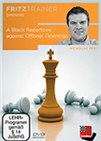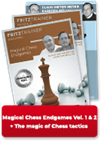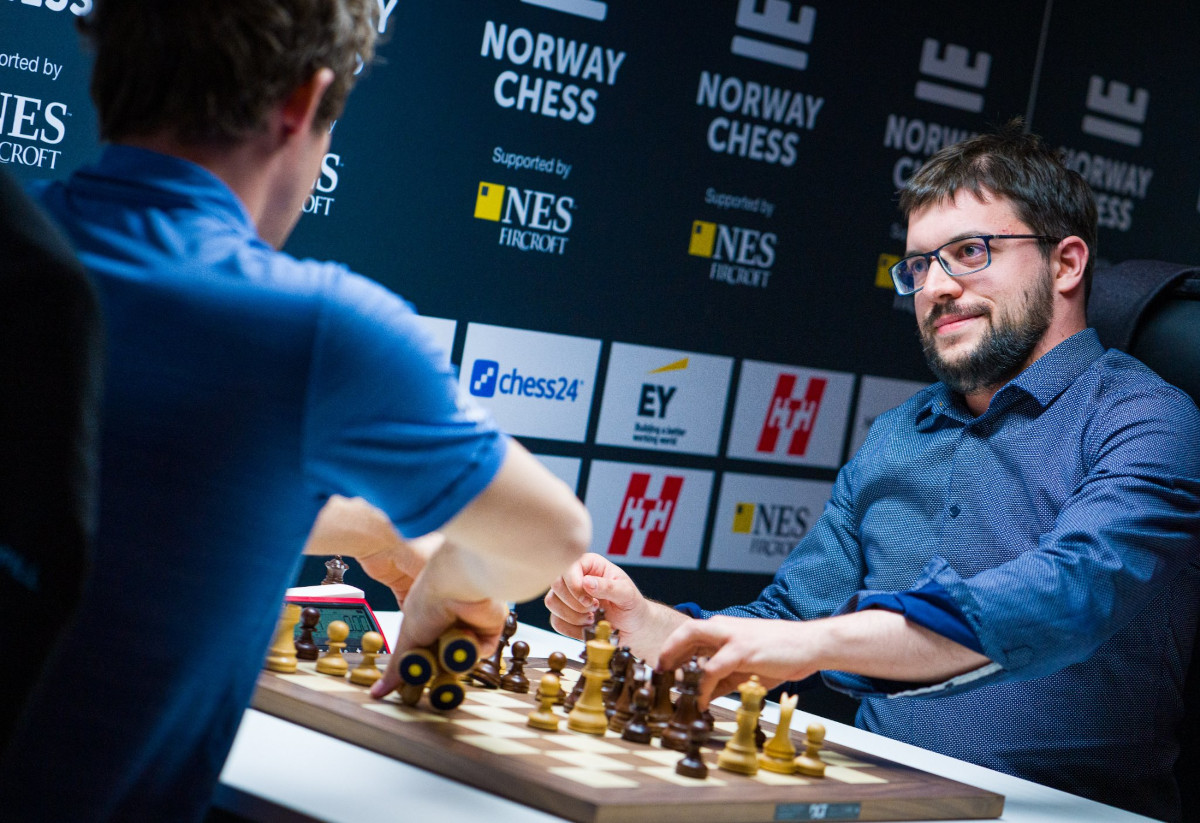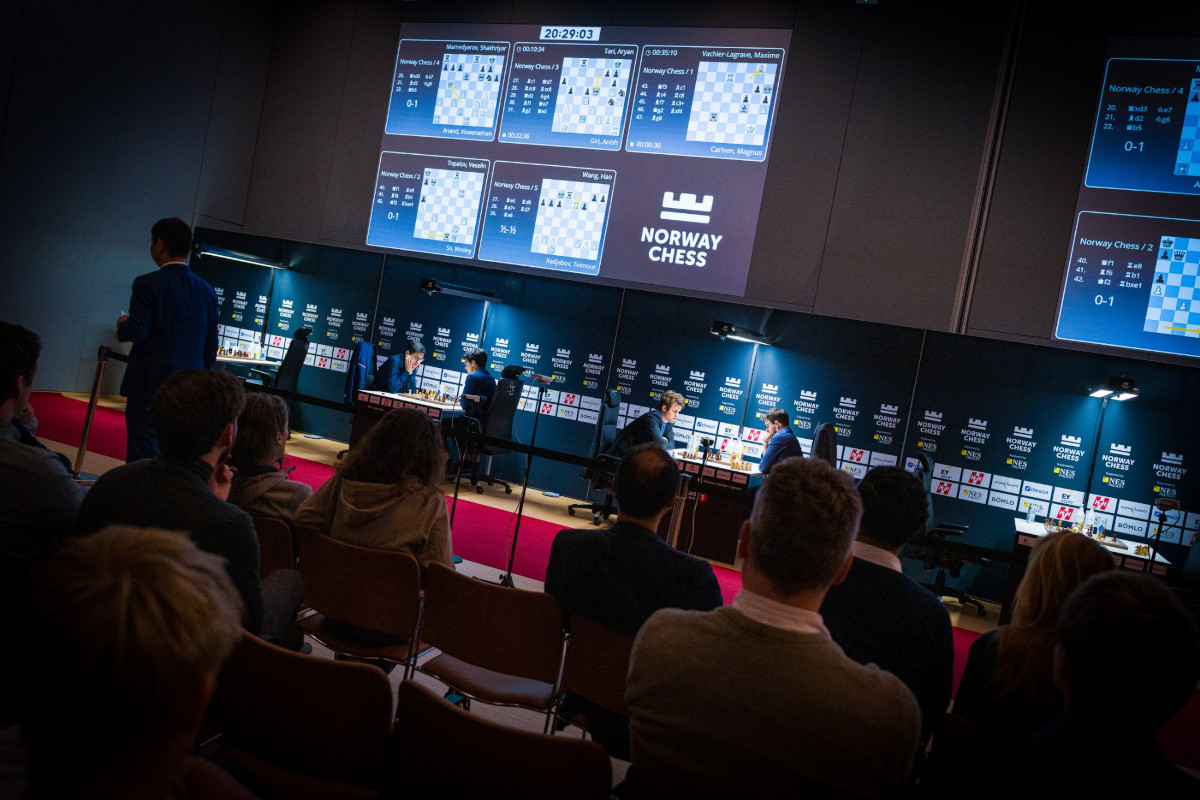A quick resignation
Vishy Anand and Shakhriyar Mamedyarov played fourteen moves of theory out of a Petroff Defence in the penultimate round of the Norway Chess Tournament. The Indian, playing white, soon pushed his g-pawn in front of his king, and a strategic middlegame battle ensued. It was clear that the two fighting players were in for a tough struggle — when the game abruptly came to an end.
The former world champion played 22.Qb5, wrote down his move, realized what had just happened, and extended his hand in resignation when his opponent returned to the board after going for a stroll. Anand saw — a bit too late — that 22...Qxf3 wins on the spot, since 23.Kxf3 fails to 23...Nh4#.
 Many club players have their favourite pet opening variations which aren’t necessarily main lines. It’s important to know how to handle these variations as your opponent will likely know his systems well. In this DVD, GM Nicholas Pert provides a detailed Black repertoire against many of these Offbeat Opening choices.
Many club players have their favourite pet opening variations which aren’t necessarily main lines. It’s important to know how to handle these variations as your opponent will likely know his systems well. In this DVD, GM Nicholas Pert provides a detailed Black repertoire against many of these Offbeat Opening choices.As Mamedyarov told the commentators later, he noticed something was wrong when he returned to the board and saw Anand’s face. The Azerbaijani confessed that he had foreseen the move Qb5, as it is the most natural, active manoeuvre in the position — except for the fact that it loses on the spot, of course. Had Anand not resigned immediately, he would have inevitably found the winning move. As he told Jovanka Houska:
This beautiful move ...Qxf3, if I would start to think, I would [play] in 2-3 minutes, because every time I calculate how to sacrifice something.
From Anand’s perspective, it is understandable that he did not wait for Shakh to find the move before resigning. Playing such a blunder — and noticing you have done it seconds after making the move — is not an easy pill to swallow, especially after having shown such a strong performance throughout the event.

Shakhriyar Mamedyarov | Photo: Lennart Ootes
At that point, Mamedyarov had taken the sole lead in the standings, since this was his second consecutive win in a classical game (scoring 3 points each time). Magnus Carlsen, who entered the round as the leader, was playing white against Maxime Vachier-Lagrave.
MVL predictably played the Grünfeld against 1.d4, and found himself a pawn to the good once the time control was reached. The Frenchman increased his material advantage as the position was simplified into an endgame with rooks and bishops of opposite colours. On move 48, he failed to find a tricky sequence which would have won him the game.
48...Kg6 was followed by 49.Rd5 g4 50.Bxf5, and White can draw the endgame with precise play. Instead, 48...gxh4 was winning — after 49.Bxf5 h3+ 50.Bxh3 Rg3+ 51.Kh2, however, there is only one winning continuation for Black.
 In over 4 hours in front of the camera, Karsten Müller presents to you sensations from the world of endgames - partly reaching far beyond standard techniques and rules of thumb - and rounds off with some cases of with own examples.
In over 4 hours in front of the camera, Karsten Müller presents to you sensations from the world of endgames - partly reaching far beyond standard techniques and rules of thumb - and rounds off with some cases of with own examples.
51...Bb8 is the crucial manoeuvre! Black is threatening to win a piece with a discovered check, but the bishop is protected by the king and the rook is protected by the bishop.
‘Wasting’ a move with the bishop might lead to zugzwang, but there is only one square from which everything falls into place for Black — d6 and c7 are protected by the rook, while 51...Be5 fails to 52.Rd5 or 52.Re7, attacking the bishop.
But 51...Bb8 does work, since 52.Rb7 loses to 52...Rb3+ and 52.Rd8 loses to 52...Rg8+ (diagram below). Beautiful geometry!
Unfortunately for him, though, MVL did not find this good-looking continuation. Moreover, he missed another difficult-to-find technical winning recourse ten moves later. Carlsen eventually managed to save the draw and went on to win an extra half point by beating the Frenchman in the Armageddon decider.
Go over both games from the mini-match in the replayer below.

Maxime Vachier-Lagrave would have gone into the final round tied for first place had he defeated the world champion in their classical game | Photo: Lennart Ootes
The results of round 8 — in which Anish Giri was the one other player to win his classical game — left Carlsen in the sole lead, a half point ahead of Mamedyarov and two points ahead of Anand. These three players and Vachier-Lagrave still have chances to win the event.
While Carlsen will play black against Veselin Topalov, Mamedyarov will face Teimour Radjabov with the white pieces. Hopefully, we will not see a quick draw in the all-Azerbaijani encounter, as Shakh has good chances of winning the super-tournament in Stavanger.
Round 9 pairings
| White |
|
Black |
| Veselin Topalov |
- |
Magnus Carlsen |
| Shakhriyar Mamedyarov |
- |
Teimour Radjabov |
| Aryan Tari |
- |
Viswanathan Anand |
| Maxime Vachier-Lagrave |
- |
Anish Giri |
| Wang Hao |
- |
Wesley So |

A national hero — Magnus Carlsen | Photo: Lennart Ootes
Standings after round 8
| |
Name |
Points |
| 1 |
Magnus Carlsen |
15 |
| 2 |
Shakhriyar Mamedyarov |
14½ |
| 3 |
Viswanathan Anand |
13 |
| 4 |
Maxime Vachier-Lagrave |
12½ |
| 5 |
Wesley So |
11 |
| 6 |
Anish Giri |
11 |
| 7 |
Aryan Tari |
8½ |
| 8 |
Veselin Topalov |
8½ |
| 9 |
Wang Hao |
6½ |
| 10 |
Teimour Radjabov |
6½ |
All games
Links


























